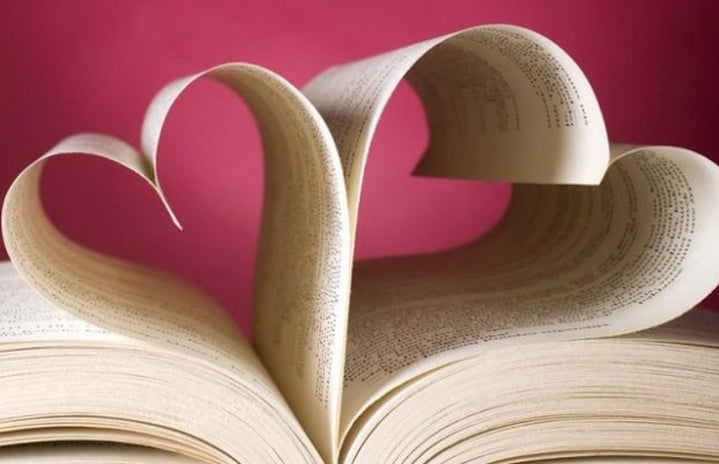The first time I wanted to read a book with a half-naked man on the cover, I was twelve years old. At that point, I had already read a fair share of novels I probably shouldn’t have, speared onward by my middle school librarian and a need to satisfy an above-average reading level. I didn’t understand that the content of my beloved stories was beyond my age range in events rather than vocabulary. I was a sixth-grader in Texas. No one cared what I was reading so long as I didn’t mention it.
The half-naked man was Jace Herondale. He was blond and ripped and covered in sick, symbolic tattoos. The cover cut off his face. You could only see his lips subtly pressed together and the curling tendrils of blonde hair brushing broad shoulders and a smooth, strong chest. He was the shining background of a cityscape. I always assumed skylines were of New York. The book was stocked in the fantasy section of the library which had become my niche genre in the past few years. I bent down to pick it up, intrigued by the title, City of Bones, and began skimming the synopsis.
Jace wasn’t a mafia leader or a drug dealer or some rich inked-out guy trying to seduce a female coworker. He was a Shadowhunter- a highly trained teenage warrior working to protect humans, known as mundanes, from demons only his kind can see. It sounded like a killer urban fantasy to me, complete with magic powers and a female protagonist saving the day. I stood, tucking the hulking book beneath my arm, and turned to leave.
“You really shouldn’t read that,” I heard behind me. The voice was soft but harsh. I could feel the judgment in her stare before pivoting to meet her gaze. I don’t remember her name now, but I recall with stunning clarity her tone, like chiseled ice. “My mom says it’s awful. It has nasty stuff in it. Smart girls don’t read things like that.”
I was shocked. My choice in reading material had never been questioned before, yet here I was, feeling the wrath of a classmate’s mother, blushing tomato and frozen in place. I stayed like that for a moment, not sure how to respond. Eventually, she must have deemed me old news. She dropped her eyes, stood up from her crouched position, and left the library with a thick book in her own grasp.
It was Twilight.
That day sticks to me even now. It feels like the catalyst for so many of my literary passions. I read the book anyway, of course. Tackled the entire seven-book series actually over the course of the following year. The most any character did was kiss until book five, when an anticlimactic fade-to-black scene was the culmination of impropriety. That shouldn’t matter anyway. The cover shouldn’t have either. I enjoyed the book and the plot and the characters, and that should have been enough to label it entertaining and meaningful to me.
My entire life since then, I and other young women have been looked down upon for their choice of reading. Specifically, the genre of fiction, subcategorized into fantasy and romance, is viewed as lesser. Less academic, less important, less well-written, less respected. This disdain, the judging stares from men on planes or librarians in hallways, is ironic and unnecessary. What makes a book like City of Bones less worthy of loving readership?
Because books aimed at women are considered junk. Junk food, trashy, poorly written, whatever convenient adjective suits them. The irony in it is, women read more fiction than men anyways. In fact, women read more than men in every category of literary consumption, from physical texts to audiobooks, according to the Pew Research Center. 82% of women had read at least one book in 2013 compared to 69% of men. While this gap has closed slightly over the years, women still drive the book industry. Romance and erotica is the highest selling genre, worth an approximate whopping $1.44 billion dollars. And why is the genre, featuring and written by women, so popular? It depicts female happiness. The protagonist is special in some capacity, sometimes gifted with magic in fantastical cases, and spearheads the story to her own will. She is independent, smart, and has actual personality traits. She has ambitions and desires, and chooses to have a romantic addition to her life, but does not need it. These novels have characters who treat women with respect, love, and adoration. Reading these books is a woman’s reclamation of relationships. It’s the ability to imagine tangible success and joy, the agency to redefine love and demand more from partners in life. It’s the right to feel seen and heard and understood while reading. It’s connection and validation.
“Reading these books is a woman’s reclamation of relationships.”
I felt those feelings before knowing the dominating statistics. I read books by Sarah J. Maas and Veronica Roth and Emily Henry and Ali Hazelwood. I spanned across genres, but I never abandoned the creators. In reading books by women, with strong female leads, with lessons of joy and reality, I grew into who I am today. I refuse to feel shame for styles of cover. I refuse to feel forced into secrecy of content. While every work of words is perfectly subject to critique, they are not supposed to lay armorless to insults spewed by those who are classically judging by the cover.
A book can have sex and romance (or magic, too) and still speak on other topics. Authors discuss family relationships, politics, mental health, abuse, and more, but these subjects are ignored as secondary additions when it’s a woman’s work under scrutiny. Love should not take away from the weight of other plotlines, and it doesn’t. As in life, love exists simultaneously alongside challenges and loss. Women exist alongside men. They deserve to be written about and seen. We deserve to write and read what we want.
“As in life, love exists simultaneously alonside challenges and loss. Women exist alongside men.”
The cover of City of Bones and the rest of The Mortal Instruments series has since been remade. In 2015, the cut-off characters backing the setting’s skyline were replaced with fully clothed, head-to-toe characters frozen in a single second of story. They’re nice pieces of art, eye-catching and informative, but they exemplify the discretion we’ve adapted when it comes to reading books for the female gaze. I don’t know a single book nerd who hasn’t tried and enjoyed Cassandra Clare’s books. But I met them all later in life as BookTok and Bookstagram and BookTube became popular outlets for common expression.
If you want to read a book, read it. Enjoy it. Carry the hardcover monstrosity around. Its content is not diminished by the addition of sex or female power or romance or vampires or werewolves or a scandalous cover. There’s no such thing as a guilty pleasure. It’s all just pleasure.


